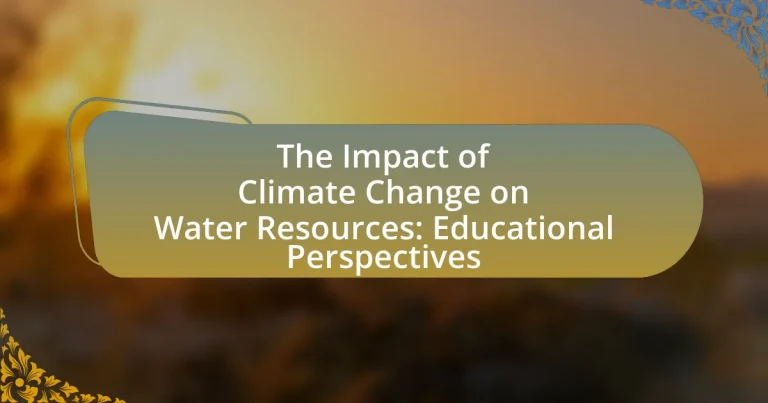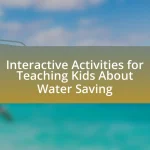The article examines the significant impact of climate change on water resources, highlighting alterations in precipitation patterns, increased evaporation rates, and the degradation of water quality. It discusses how these changes lead to reduced freshwater availability, affecting agriculture, drinking water supplies, and ecosystems. Key factors influencing freshwater availability include altered precipitation, evaporation, and glacial melt, while the consequences for biodiversity and ecosystem health are also addressed. Furthermore, the article emphasizes the role of education in promoting sustainable water management practices and raising awareness about water conservation in the context of climate change.
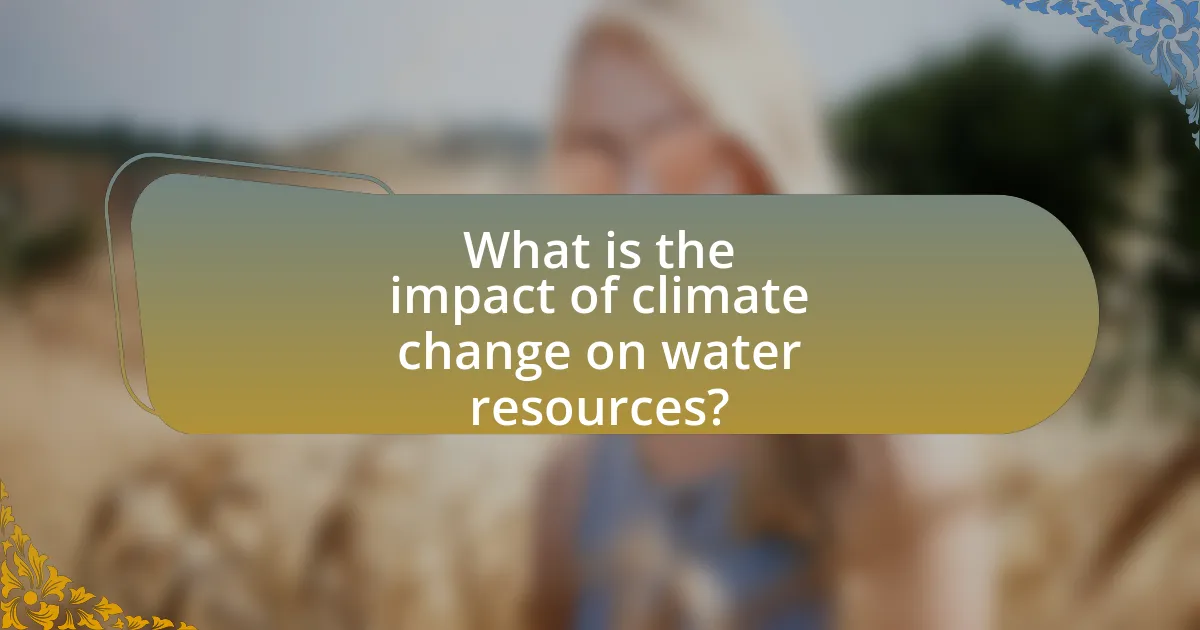
What is the impact of climate change on water resources?
Climate change significantly impacts water resources by altering precipitation patterns, increasing evaporation rates, and affecting water quality. These changes lead to more frequent and severe droughts in some regions, while others may experience increased flooding. For instance, the Intergovernmental Panel on Climate Change (IPCC) reports that global warming is expected to increase the intensity and frequency of extreme weather events, which directly influences the availability and distribution of freshwater resources. Additionally, rising temperatures can lead to the degradation of water quality due to increased runoff and the proliferation of harmful algal blooms, further stressing water supplies.
How does climate change affect the availability of freshwater?
Climate change significantly reduces the availability of freshwater by altering precipitation patterns and increasing evaporation rates. As global temperatures rise, regions experience more intense droughts and irregular rainfall, leading to decreased surface water and groundwater recharge. For instance, the Intergovernmental Panel on Climate Change (IPCC) reports that many areas are projected to face a decline in freshwater resources due to these changes, with some regions experiencing up to a 20% reduction in water availability by 2050. This reduction in freshwater availability poses challenges for agriculture, drinking water supply, and ecosystem health.
What are the primary factors influencing freshwater availability due to climate change?
The primary factors influencing freshwater availability due to climate change include altered precipitation patterns, increased evaporation rates, and the melting of glaciers. Altered precipitation patterns lead to more intense rainfall events and prolonged droughts, which disrupt the natural replenishment of freshwater sources. Increased evaporation rates, driven by higher temperatures, reduce surface water levels in lakes and rivers, further diminishing available freshwater. Additionally, the melting of glaciers, which serve as critical freshwater reservoirs, threatens long-term water supply in many regions, particularly in mountainous areas where communities rely on glacial meltwater for drinking and irrigation. These factors collectively contribute to the growing challenges in managing freshwater resources in the context of climate change.
How do changes in precipitation patterns impact freshwater resources?
Changes in precipitation patterns significantly impact freshwater resources by altering the availability and distribution of water. For instance, increased rainfall intensity can lead to flooding, which may cause surface runoff and reduce groundwater recharge, while prolonged droughts can diminish river flows and deplete reservoirs. According to the Intergovernmental Panel on Climate Change (IPCC), regions experiencing shifts in precipitation are likely to face challenges in maintaining water supply, with some areas projected to see a decrease in freshwater availability by up to 30% by 2050. This variability in precipitation not only affects the quantity of freshwater but also its quality, as changes can lead to increased pollution and sedimentation in water bodies.
What are the consequences of altered water resources on ecosystems?
Altered water resources lead to significant consequences for ecosystems, including habitat loss, species decline, and changes in biodiversity. When water availability is modified due to climate change, ecosystems experience stress, which can result in the displacement of aquatic and terrestrial species. For instance, altered flow regimes in rivers can disrupt spawning cycles of fish, leading to population declines. Additionally, changes in water temperature and chemistry can affect the health of aquatic organisms, such as coral reefs, which are sensitive to temperature fluctuations. Research indicates that approximately 40% of freshwater species are at risk of extinction due to habitat degradation linked to altered water resources. These changes not only impact individual species but also disrupt food webs and ecosystem services, ultimately affecting human communities that rely on these ecosystems for resources and recreation.
How does climate change-induced water scarcity affect biodiversity?
Climate change-induced water scarcity significantly reduces biodiversity by altering habitats and disrupting ecosystems. As water availability decreases, many species face habitat loss, leading to population declines and increased extinction risks. For instance, freshwater ecosystems, which are already vulnerable, experience heightened stress, resulting in diminished species richness. Research indicates that approximately 20% of freshwater species are at risk of extinction due to climate-related changes in water availability. Furthermore, altered water cycles can lead to changes in plant communities, affecting the entire food web and further threatening species that rely on specific habitats.
What role do aquatic ecosystems play in mitigating climate change effects?
Aquatic ecosystems play a crucial role in mitigating climate change effects by sequestering carbon dioxide and regulating local climates. These ecosystems, including wetlands, rivers, and oceans, absorb significant amounts of carbon, with coastal wetlands alone storing approximately 50% of the carbon found in terrestrial ecosystems. Additionally, aquatic plants, such as seagrasses and phytoplankton, contribute to carbon fixation through photosynthesis, further reducing atmospheric CO2 levels. The health of these ecosystems is vital, as they also provide services like flood regulation and water purification, which are essential in adapting to climate change impacts.
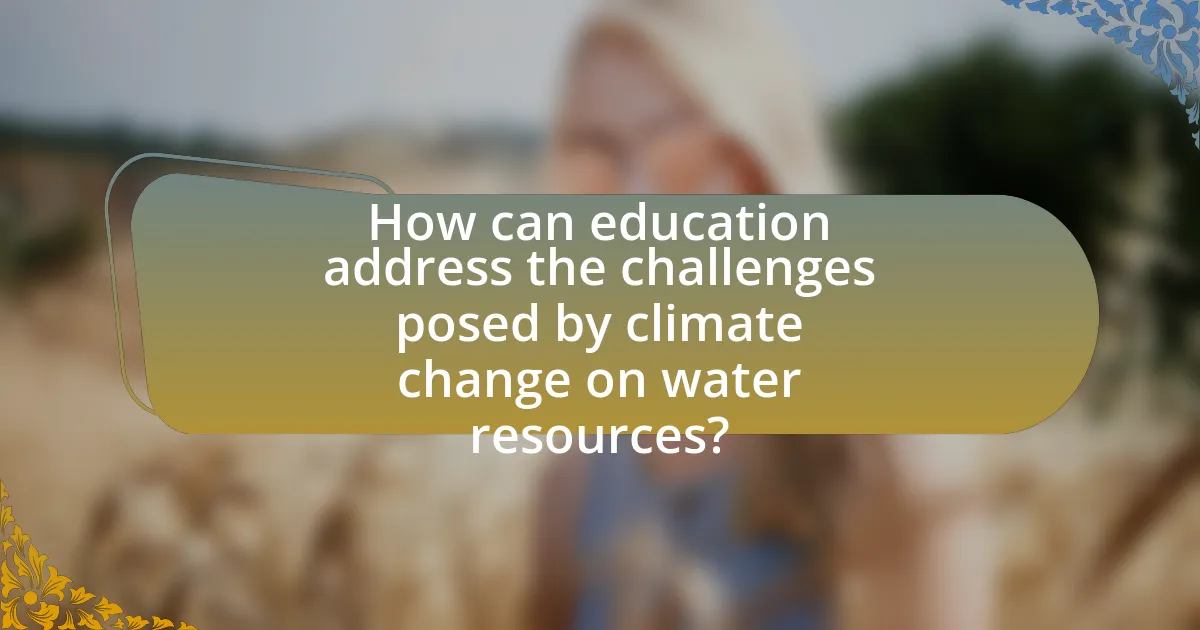
How can education address the challenges posed by climate change on water resources?
Education can address the challenges posed by climate change on water resources by equipping individuals with knowledge and skills to manage water sustainably. Through curricula that focus on climate science, water conservation techniques, and the socio-economic impacts of water scarcity, education fosters awareness and encourages proactive behaviors. For instance, programs that teach students about the water cycle and the effects of climate change can lead to informed decision-making regarding water use and conservation practices. Research indicates that educational initiatives, such as the UNESCO-led “Water Education for Sustainable Development” program, have successfully increased community engagement in water resource management, demonstrating the effectiveness of education in mitigating climate-related water challenges.
What educational strategies can raise awareness about water resource issues?
Educational strategies that can raise awareness about water resource issues include experiential learning, community engagement, and interdisciplinary curricula. Experiential learning, such as field trips to local water bodies or conservation projects, allows students to observe and understand water issues firsthand. Community engagement initiatives, like local clean-up events or water conservation campaigns, foster a sense of responsibility and connection to water resources. Interdisciplinary curricula that integrate science, social studies, and environmental education provide a comprehensive understanding of the complexities surrounding water resources, emphasizing the impact of climate change. Research indicates that hands-on experiences and community involvement significantly enhance students’ awareness and understanding of environmental issues, including water resource management.
How can schools incorporate climate change and water resource education into their curricula?
Schools can incorporate climate change and water resource education into their curricula by integrating interdisciplinary lessons that connect environmental science, geography, and social studies. This approach allows students to understand the scientific principles of climate change, its effects on water resources, and the socio-economic implications. For example, a study by the National Oceanic and Atmospheric Administration (NOAA) highlights that educational programs focusing on real-world applications, such as local water conservation efforts, significantly enhance student engagement and understanding of climate issues. Additionally, hands-on projects, such as water quality testing and community clean-up initiatives, can provide practical experience and foster a sense of responsibility towards environmental stewardship.
What role do community programs play in educating the public about water conservation?
Community programs play a crucial role in educating the public about water conservation by providing targeted information, resources, and hands-on experiences that promote sustainable practices. These programs often include workshops, informational campaigns, and community events that raise awareness about the importance of conserving water, especially in the context of climate change, which exacerbates water scarcity. For instance, studies have shown that communities engaged in educational programs can reduce water usage by up to 20% through increased awareness and behavioral changes. By fostering a sense of community responsibility and equipping individuals with practical tools, these programs effectively enhance public understanding and engagement in water conservation efforts.
How can educational institutions promote sustainable water management practices?
Educational institutions can promote sustainable water management practices by integrating water conservation education into their curricula and implementing practical water-saving measures on campus. By teaching students about the importance of water resources and the impact of climate change, institutions can raise awareness and foster responsible behaviors. For instance, universities can adopt rainwater harvesting systems and install water-efficient fixtures, demonstrating sustainable practices in action. Research indicates that educational programs focused on environmental sustainability can lead to a 20% reduction in water usage in participating institutions, showcasing the effectiveness of such initiatives.
What best practices can be taught to students for effective water resource management?
Best practices for effective water resource management that can be taught to students include implementing water conservation techniques, understanding the water cycle, and promoting sustainable practices. Teaching students about water conservation techniques, such as fixing leaks, using water-efficient appliances, and practicing mindful water usage, can significantly reduce water waste. Understanding the water cycle helps students appreciate the importance of maintaining water quality and quantity. Promoting sustainable practices, such as rainwater harvesting and responsible agricultural practices, encourages students to engage in activities that protect and preserve water resources. These practices are supported by studies indicating that education on water management leads to improved water conservation behaviors and increased awareness of water-related issues.
How can technology be integrated into education to enhance water resource awareness?
Technology can be integrated into education to enhance water resource awareness through interactive digital platforms, simulations, and data visualization tools. These technologies allow students to engage with real-time data on water usage, quality, and availability, fostering a deeper understanding of water resource management. For instance, platforms like WaterSense provide educational resources and tools that help students analyze water consumption patterns and the impact of climate change on local water supplies. Additionally, virtual reality experiences can immerse students in ecosystems affected by water scarcity, illustrating the consequences of climate change on water resources. Research indicates that using technology in education significantly improves student engagement and retention of information, making it a powerful tool for raising awareness about critical issues like water resources.
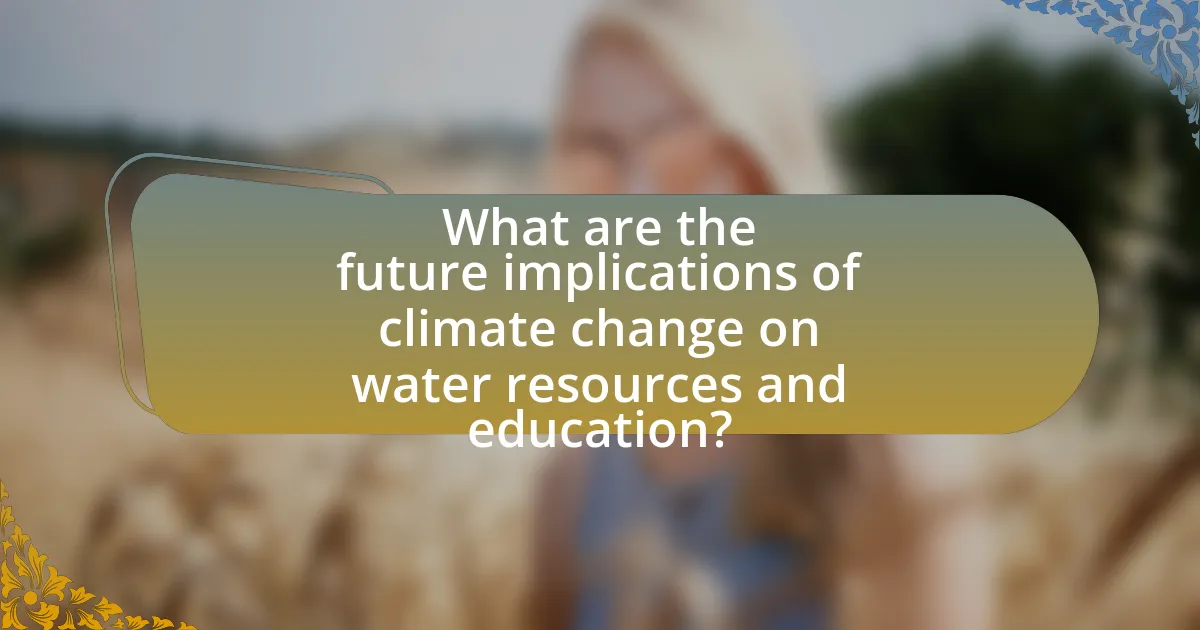
What are the future implications of climate change on water resources and education?
Climate change will significantly impact water resources and education by exacerbating water scarcity and altering educational access and quality. As global temperatures rise, increased evaporation and altered precipitation patterns will lead to diminished freshwater availability, affecting agricultural productivity and drinking water supplies. For instance, the Intergovernmental Panel on Climate Change (IPCC) reports that by 2050, up to 1.8 billion people may live in areas with absolute water scarcity, which will hinder educational opportunities, particularly for girls who often bear the burden of water collection. Additionally, educational institutions may face challenges in maintaining infrastructure and resources due to flooding and droughts, further disrupting learning environments. This dual impact necessitates integrating climate education into curricula to prepare future generations for these challenges.
How will climate change continue to shape water resource availability in the coming decades?
Climate change will significantly reduce water resource availability in the coming decades due to increased temperatures and altered precipitation patterns. Rising global temperatures lead to more evaporation from water bodies and soil, diminishing surface water supplies. Additionally, climate models predict shifts in rainfall distribution, with some regions experiencing intensified droughts while others face increased flooding, further complicating water management. For instance, the Intergovernmental Panel on Climate Change (IPCC) reports that by 2050, up to 1.8 billion people may live in areas with absolute water scarcity, highlighting the urgent need for adaptive strategies in water resource management.
What predictions can be made about water resource distribution due to climate change?
Predictions about water resource distribution due to climate change indicate that regions will experience altered precipitation patterns, leading to increased water scarcity in some areas and flooding in others. Climate models project that warmer temperatures will intensify evaporation rates, reducing surface water availability, particularly in arid and semi-arid regions. For instance, the Intergovernmental Panel on Climate Change (IPCC) reports that by 2050, water availability could decrease by up to 30% in certain regions, exacerbating existing water stress. Additionally, glacial melt, which currently contributes to river flows, is expected to decline, further impacting water supply in downstream areas reliant on glacial runoff.
How might future educational initiatives evolve to address ongoing water resource challenges?
Future educational initiatives may evolve by integrating interdisciplinary approaches that combine environmental science, policy, and community engagement to effectively address ongoing water resource challenges. These initiatives could focus on hands-on learning experiences, such as water conservation projects and local ecosystem studies, which have been shown to enhance student understanding and commitment to sustainable practices. For instance, programs like Project WET (Water Education for Teachers) have successfully increased awareness and knowledge about water issues among students and educators, demonstrating the effectiveness of experiential learning in fostering responsible water stewardship.
What practical steps can individuals take to mitigate the impact of climate change on water resources?
Individuals can mitigate the impact of climate change on water resources by adopting water conservation practices. Implementing measures such as fixing leaks, using water-efficient appliances, and collecting rainwater can significantly reduce water waste. According to the U.S. Environmental Protection Agency, fixing household leaks can save an average of 10,000 gallons of water per year. Additionally, reducing water usage in landscaping by utilizing drought-resistant plants can further conserve water. These actions collectively contribute to preserving water resources in the face of climate change.
How can individuals contribute to water conservation efforts in their communities?
Individuals can contribute to water conservation efforts in their communities by implementing practices such as reducing water waste, using water-efficient appliances, and participating in local conservation programs. For instance, fixing leaks in plumbing can save significant amounts of water; the U.S. Environmental Protection Agency estimates that fixing leaks can save an average household about 10,000 gallons of water annually. Additionally, using drought-resistant plants in landscaping can reduce outdoor water use, which is crucial in areas facing water scarcity due to climate change. Engaging in community clean-up events to protect local water sources also fosters a collective responsibility towards water conservation.
What resources are available for individuals seeking to educate themselves on water sustainability?
Individuals seeking to educate themselves on water sustainability can access a variety of resources, including online courses, books, and organizations dedicated to water conservation. For instance, platforms like Coursera and edX offer courses on water management and sustainability, often created by reputable universities. Books such as “Water: The Epic Struggle for Wealth, Power, and Civilization” by Steven Solomon provide historical and contextual insights into water issues. Additionally, organizations like the World Resources Institute and the Water Environment Federation provide valuable research, reports, and educational materials focused on sustainable water practices. These resources collectively enhance understanding and promote effective strategies for water sustainability.
